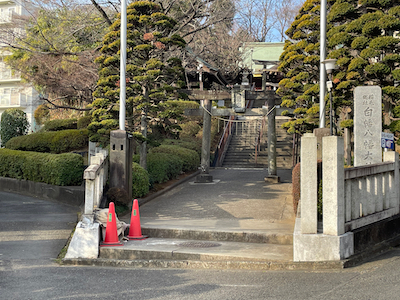A couple of days ago I was talking to the priests at my local jinja about entirely practical issues.
The first was the destruction of one of the stone pillars at the entrance. These were put up about 45 years ago when the jinja was rebuilt, and are (or were) carved with the names of the people who supervised, and helped pay for, the rebuilding.

The pillar was destroyed earlier this week when a large truck tried to go up the road alongside the jinja, and it didn’t really fit. Because the vehicle was wide and long, it couldn’t reverse either, so it forced its way through, destroying the pillar and a couple of signs. The driver then just drove off.
This was not very effective, as the noise had brought people out, and they had taken photographs on their phones. The police were called, tracked the truck down, and got the incident properly recorded. The insurance company have already sent someone, and the jinja has an estimate for replacing the pillar, so this is likely to be a short-term problem, at least for the jinja.
The priests said that this sort of thing happens quite a lot. This is, I think, the first time that the damage has been so major, but the road is narrow there, and there is a wall on the other side as well, so smaller bumps from cars that do not quite make the turn are not that unusual. I imagine that this sort of problem is fairly common for jinja in urban areas, although the details no doubt differ. The road junction at Shirahata-san’s entrance is particularly dangerous-looking, and it wouldn’t surprise me if someone accidentally drove straight into the jinja at night, while drunk.
The other problem was with an insect infestation of some of the trees. These insects feed on the sap, and leave the trees vulnerable to pollutants in the air. The pollutants gather and the leaves and bark turn black, and ultimately the trees die under the dual assault.
The treatment, it seems, is to cut off as many infected extremities as possible and then use pesticide on the trees to kill the remaining insects. If that is done early, the infestation can be stopped before it spreads to the whole of the sacred forest. (At Shirahata-san it is currently limited to a small area, and it was being treated while I was there.)
This sort of problem is, of course, not covered by anyone else’s insurance, so the jinja has to be able to pay for it. These insects are a problem across Japan, which creates an additional expense for anyone trying to maintain a jinja and its forest. I do not think it is a major problem for Shirahata-san, but for jinja in more isolated areas, the priest might not notice the problem before the insects have spread, because they would not visit the jinja that often, and then there might well not be enough money to treat the infected area.
I suspect that these little things are, collectively, the biggest threat to jinja. In rural areas, the number of ujiko drops, and while the jinja keeps going, no-one can afford to fix these sorts of problems, and so the structure gently falls apart, until no-one remembers where the jinja was, and little evidence remains.
That, however, is not going happen to Shiarahata-san in the foreseeable future.
Pingback: Repairs – Mimusubi